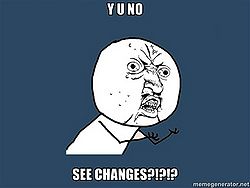Difference between revisions of "Mirdori"
Dhempstead (talk | contribs) (→Prioritized List of Secondary Sources) |
(→Prioritized List of Secondary Sources) |
||
| Line 100: | Line 100: | ||
| 1 || Current Approaches to Change Blindness || [http://citeseerx.ist.psu.edu/viewdoc/download?doi=10.1.1.113.9171&rep=rep1&type=pdf PDF] || || B || || | | 1 || Current Approaches to Change Blindness || [http://citeseerx.ist.psu.edu/viewdoc/download?doi=10.1.1.113.9171&rep=rep1&type=pdf PDF] || || B || || | ||
|- | |- | ||
| − | | 2 || Change-blindness as a result of mudsplashes || [http://cognitrn.psych.indiana.edu/busey/ChangeBlindness/Articles/oregan1999.pdf PDF] || || M || || | + | | 2 || Change-blindness as a result of mudsplashes || [http://cognitrn.psych.indiana.edu/busey/ChangeBlindness/Articles/oregan1999.pdf PDF] || || M || N/A || Abductive |
|- | |- | ||
| 3 || Beyond the Grand Illusion || [http://cognitrn.psych.indiana.edu/busey/ChangeBlindness/Articles/grandillusion.pdf PDF] || || B || || | | 3 || Beyond the Grand Illusion || [http://cognitrn.psych.indiana.edu/busey/ChangeBlindness/Articles/grandillusion.pdf PDF] || || B || || | ||
Revision as of 00:24, 15 November 2011
BTH740 | Weekly Schedule | Research Projects | Research Essay | Student Resources
Contents
The Team
Web Sites Reviewed
Thesis Statement
Thesis
First
Second
"Why do people not noticed the slight changes in their daily lives, but when they do notice a change, it seems like they can do nothing but complain about the change."
Third
"Throughout this paper we will examine and explore the effects of change blindness on users as they operate three fast-paced websites: Facebook, Google Mail, and MSN."
Fourth
How do the effects of change blindness negatively affect the usability of three of the most popular dynamic webpages: Facebook, Google Mail and MSN?
Fifth
How do the effects of change blindness affect the usability of three of the most popular dynamic webpages: Facebook, Google Mail and Hotmail?
Current
How do the effects of change blindness affect the usability of Facebook?
Keywords
- change blindness
- attention
- conscious/unconscious thoughts
- vision
- daily routine
- user interfaces
Bibliography
Primary
Surveys, questionaires
Secondary
Daniel J. Simons, "Current Approaches to Change Blindness", VISUAL COGNITION, 2000, 7 (1/2/3), 1-15
<http://citeseerx.ist.psu.edu/viewdoc/download?doi=10.1.1.113.9171&rep=rep1&type=pdf>
"Change Blindness", Wikipedia, 3 October, 2011
http://en.wikipedia.org/wiki/Change_blindness
Mark Frauenfelder, "Change Blindness Experiment", December 14, 2009
http://boingboing.net/2009/12/14/change-blindness-exp.html
Indiana University, "Change Blindness", February 28, 2006
http://cognitrn.psych.indiana.edu/CogsciSoftware/ChangeBlindness/
J. Kevin O'Regan, "Change Blindness Demonstrations", July 14, 2011
http://nivea.psycho.univ-paris5.fr/#CB
J. Kevin O'Regan, "Change Blindness", August 8, 2011
http://nivea.psycho.univ-paris5.fr/ECS/ECS-CB.html
Andrew Dillon, "User Interface Design", October 16, 2005
http://www.ischool.utexas.edu/~adillon/BookChapters/User%20Interface%20Design_files/User%20Interface%20Design.htm
Research Notes
Primary Research
Survey
Ask people about what they do on Facebook. This would be a check box list asking:
- Chat
- Private message
- Instant message
- Wall post messages
- Playing games
- Etc...
What do they think is the most important feature of Facebook? Do they find all the features that inform them (directly on Facebook, i.e. without email notification) about activities on Facebook inform them quick enough or well enough? Explain what they like or don't like about the system and what they might change about it.
Change Blindness Test Using Facebook
- We setup 3 Facebook accounts; 1 account for the person being tested and 2 accounts for the people performing the test.
- We used a total of 3 laptops
- One laptop would have the person being tested, this laptop would have screen capturing software running to record the actions of the users while seeing notifications appearing on the screen.
- We setup a camera which was pointed at the person being tested to capture the eye movement so we could capture where they were looking, whether their eyes are fixed at the chat window all the time or do they look around the screen.
- The other laptops which were used to test communicate with the person being tested.
- One tester chatted with the person being tested (using Facebook chat)
- The other tester would perform events that would cause notifications on the person being tested's computer.
- When the person being tested saw a notification appear, they were asked to say "Notification".
- One laptop would have the person being tested, this laptop would have screen capturing software running to record the actions of the users while seeing notifications appearing on the screen.
Prioritized List of Secondary Sources
| Position | Title | Original Link | Commented Document | Who | Additional Comments/Thoughts | Type of conclusions |
|---|---|---|---|---|---|---|
| 1 | Current Approaches to Change Blindness | B | ||||
| 2 | Change-blindness as a result of mudsplashes | M | N/A | Abductive | ||
| 3 | Beyond the Grand Illusion | B | ||||
| 4 | Neural correlates of change detection and change blindness | File:BeckRees.pdf | D | Interesting article, however mainly talked about research that was done using MRI's and how the brain reacts during change blindness tests. I don't think for our tests we could test anything this in depth. | Deductive | |
| 5 | Change blindness: Past, present, and future | B | ||||
| 6 | Change Blindness Blindness: The Metacognitive Error of Overestimating Change-detection Ability | N/A | D | Good article that we could use to help present the findings of our primary research, however there was little to nothing of value for our subject since it did not have anything to do directly with our thesis, but more with presenting the findings from someone elses research. | Deductive | |
| 7 | |
N/A | M | This has been dismissed because of the fact that there are spelling mistakes. SPELLING AND GRAMMAR MISTAKES. | Dismissed |
Notes
Current Approaches to Change Blindness - Daniel J. Simons - Harvard University, Cambridge, MA, USA
Highlights and Quotes
"Across saccades, blinks, blank screens, movie cuts, and other interruptions, observers
fail to detect substantial changes to the visual details of objects and
scenes." (pg. 1)
"People also show change blindness
when the original and altered image are separated by a “mudsplash” (O’Regan,
Rensink, & Clark, 1999), by a cut or pan in a motion picture (Hochberg, 1986;
Levin & Simons, 1997; Simons, 1996), and even by a real-world disruption
(Simons & Levin, 1998)." (pg.2)
"Phillips,
1974; Simons, 1996). In the flicker paradigm, an original and modified image
are presented in rapid alternation with a blank screen between them. Observers
respond as soon as they detect the changing object. Research using this paradigm
has produced two primary findings: (1) observers rarely detect changes
during the first cycle of alternation, and some changes are not detected even
after nearly 1 minute of alternation (Rensink et al., 1997); and (2) changes to
objects in the “centre of interest” of a scene are detected more readily than
peripheral or “marginal interest” changes (Rensink et al., 1997),"
(pg.3)
"Both the flicker paradigm and the forced choice detection paradigm are
intentional change detection tasks in that observers know that changes will
occur and actively search the display to find differences. This work demonstrates
that observers are change blind evenwhen their primary task is to search
for change."
(pg.4)
Outline of the Argument
- Introduction
- What is Change Blindness?
- Describe our topic
- Describe our thought process for doing our primary research
- What did we do for our research
- Results of our findings
- Compare the results from the survey and the change blindness test to see if what people perceive they see matches what we saw.
- Conclusion

